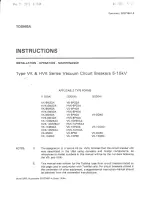
3-36
B30 BUS DIFFERENTIAL SYSTEM – INSTRUCTION MANUAL
DIRECT INPUT AND OUTPUT COMMUNICATIONS
CHAPTER 3: INSTALLATION
3
3.4 Direct input and output communications
3.4.1 Description
The direct inputs and outputs feature makes use of the type 7 series of communications modules and allows direct
messaging between UR devices. The communications modules are outlined in the table later in this section.
The communications channels are normally connected in a ring configuration, as shown in the following figure. The
transmitter of one module is connected to the receiver of the next module. The transmitter of this second module is then
connected to the receiver of the next module in the ring. This is continued to form a communications ring. The figure
illustrates a ring of four UR-series relays with the following connections: UR1-Tx to UR2-Rx, UR2-Tx to UR3-Rx, UR3-Tx to
UR4-Rx, and UR4-Tx to UR1-Rx. A maximum of 16 URs can be connected in a single ring.
Figure 3-34: Direct input and output single-channel connection
Inter-relay communication (IRC) modules with protocol C37.94 and G.703 are designed for back-to-back communication
connections, so the ring configuration shown in the previous figure does not apply. To establish inter-relay communication
in more than two URs, you need to have a two-channel IRC module and enable the
DIRECT I/O CHANNEL CROSSOVER
setting
in all relays, as shown in the next figure. This configuration can be expanded to 16 URs, and this configuration does not
provide a redundancy ring since both channels are made into a single ring by the channel crossover function. As per the
figure entitled Typical Pin Interconnection between Two G.703 Interfaces later in this chapter, the clock is supplied typically
by multiplexer (MUX) and all URs are in Loop Timing Mode. If there is no MUX, then UR1 and UR3 can be in Internal Timing
Mode and UR2 and UR4 can be in Loop Timing Mode. That is, connected channels must have opposite timing modes.
Figure 3-35: Ring configuration for C37.94 module (concept also applies to G.703)
The interconnection for dual-channel type 7 communications modules is shown as follows. Two-channel modules allow for
a redundant ring configuration. That is, two rings can be created to provide an additional independent data path. The
required connections are: UR1-Tx1 to UR2-Rx1, UR2-Tx1 to UR3-Rx1, UR3-Tx1 to UR4-Rx1, and UR4-Tx1 to UR1-Rx1 for the
first ring; and UR1-Tx2 to UR4-Rx2, UR4-Tx2 to UR3-Rx2, UR3-Tx2 to UR2-Rx2, and UR2-Tx2 to UR1-Rx2 for the second ring.
Summary of Contents for b30
Page 10: ...x B30 BUS DIFFERENTIAL SYSTEM INSTRUCTION MANUAL TABLE OF CONTENTS ...
Page 486: ...5 278 B30 BUS DIFFERENTIAL SYSTEM INSTRUCTION MANUAL TESTING CHAPTER 5 SETTINGS 5 ...
Page 616: ...iv B30 BUS DIFFERENTIAL SYSTEM INSTRUCTION MANUAL ABBREVIATIONS ...
Page 632: ...xvi B30 BUS DIFFERENTIAL SYSTEM INSTRUCTION MANUAL INDEX ...















































